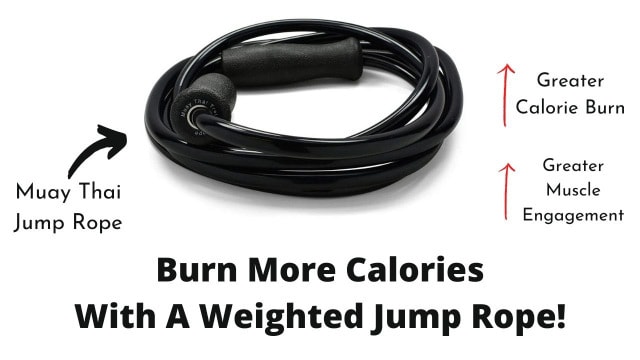If you’re like me, you’re always looking for ways to get more out of your workouts. When it comes to jumping rope, getting rid of your socks and shoes seems to be the key.
You should only jump rope barefoot once you have enough experience to jump rope with proper form. If you’re a beginner, you should learn to jump rope with your shoes on before jumping rope barefoot.
There are some incredible benefits that come from jumping rope in your bare feet. That said, it’s important to learn proper form and technique before doing so to prevent injury.

First, I’ll share some of the benefits associated with jumping rope barefoot. And then I’ll cover some tips to help you get started.
Why Should You Jump Rope Barefoot?
There are a lot of studies and information online advocating for exercising barefoot. And, if you think about it, it makes sense. Think about how much we wear shoes. Almost everything we do, besides sitting on the couch, we’re wearing shoes. The problem is, the support our shoes provide make our feet lazy. It’s not rocket science. Our feet work less, they become weaker.
For those of you new to this concept, I’ve highlighted 5 of the most significant benefits associated with jumping rope barefoot.
1. Strength
It’s crazy to think our feet contain one third of our body’s joints and 20 different muscles. It’s the very reason why it’s so important to strengthen and maintain those muscles, the same way we do our biceps… or, for you ladies, your legs. By jumping rope barefoot, your feet and ankles work harder, strengthening them a lot more than if your shoes were supporting that load.
2. Stability
Our body’s ability to be grounded, firmly, by both feet is something a lot of us take for granted. Shoes today provide so much support and in return they’ve weakened the stabilizer muscles in our feet dramatically.
By jumping rope barefoot, or exercising barefoot in general, it greatly strengthens our feet and ankle’s stabilizer muscles, allowing for more stability and better balance.
My guess is most of you don’t have an issue with this now. However, once you reach an older age balance often means something much more significant.
3. Support
The support our body’s benefit from primarily comes from the arches on our feet. The problem with shoes is they can cause these arches to weaken therefore making it harder and harder for our feet to support our bodies.
By jumping rope barefoot, and removing the unnatural support our shoes provide, it strengthens those arches and gives us the ability to support our bodies more naturally.
4. Mobility
One of the biggest benefits for me, from jumping rope barefoot, is it enables me to be lighter on my feet and quicker. Take boxers for example, they are always on the balls of their feet, just like when you’re jumping rope. This is because being on the balls of your feet keeps your energy chambered and allows you to maneuver with ease.
By jumping rope, barefoot especially, it helps to strengthen those muscles needed to rise onto the balls of your feet. It’s helped me with everything from running up a flight of stairs to dancing.
5. Health
Mallet toe, bunions, blisters, athlete’s foot, the list goes on. These are all issues that can come from wearing shoes or wearing the wrong kind of shoes for certain activities. There’s quite a bit of research that has shown people’s feet were healthier before the creation of shoes.
By jumping rope or working out barefoot, you’re allowing your feet to breath, stretch, and sweat freely resulting in healthier (and better smelling) feet!
Consider Picking Up a Weighted Jump Rope
If you’re looking to burn more calories, experience greater muscle engagement, and get an overall better workout, you might consider picking up a weighted jump rope.
The Muay Thai Jump Rope, from EliteSRS, is the weighted rope I use.
How to Jump Rope Barefoot
If you’ve decided you’d like to start jumping rope barefoot, there are some things you should think about before trying it. Here are 10 tips on how to start jumping rope barefoot!
1. Ease Into It
By no means should you lose your shoes immediately and start jumping rope barefoot. It’s important to get your feet wet first (pun intended).
Before attempting to jump barefoot, you should be at least be decent at jumping rope in your shoes. Smacking your bare toes with the cable is no fun, and likely won’t encourage you to stick with it. Secondly, I suggest starting slowly, with maybe 2 or 3 minutes of jumping without shoes. Overtime you can add another minute or two, here and there. Last thing you want to do is injure yourself.
2. Be Aware of Your Surroundings
It’s important to be conscious of your surroundings when jumping rope or working out in your bare feet. For example, if I’m at the 24 Hour Fitness down the street I’m likely going to keep my shoes on in the gym. Primarily as a courtesy to others. At least wear socks, dude.
If you’re outside, you’ll want to be careful of any debris or trash that could cause you to cut yourself. Those cuts can easily get infected. If I’m going to be jumping outside, on my back porch, a lot of times I’ll sweep first.
3. Find the Right Surface
You’ll see, in a lot of my videos, I jump rope barefoot on concrete or hardwood floors. So, I’m probably not the best example. That said, I highly suggest using a jump rope mat, or finding a matted floor to begin. Jumping on hard surfaces, like concrete or asphalt, can do long-term damage to your joints, especially if you’re not jumping with proper form. (here is the jump rope mat I use)
4. Consider Previous Injuries
This is a big one! I would hate for one of you to take some of my advice and hurt yourself. It’s critically important to consider any previous injuries or dependencies you have. If you have damaged knees or issues with your ankles, it’s probably wise to consult a doctor before jumping rope in your bare feet, let alone jumping rope at all.
At the end of the day, an injury will be the biggest set back to your training, not whether you’re wearing shoes or not.
5. Pick the Right Jump Rope
This one is going to depend a lot on your skill level. If you’ve never jumped rope before, I highly suggest starting with your shoes on. If you’ve got the basics down, and you want to give it a shot without your shoes, I’d opt for a slightly weighted jump rope which should make it a little easier. If you’re a pro, and you’ve been jumping for some time, then go with a speed rope. Making sure you’re using the right rope is important though.
List of the best jump ropes on the available: Best Jump Ropes
6. Use Proper Form
This is a huge one! You can do a lot of damage to your joints if you don’t jump rope properly. Especially if you’re barefoot. That’s why I suggest learning to jump rope in your shoes, before removing them. If you’re new to jumping rope, or looking to brush up on your form, see my post on How to Jump Rope for some of the basics.
7. Pace Yourself
It’s important to build up and strengthen the muscles in your feet before trying to bust out *30 Minutes on The Jump Rope*. If you’re used to working out in shoes, running in shoes, walking around the house in shoes, your feet likely aren’t going to benefit from an intense set in your bare feet. Take it slow and allow time for your feet to rest and heal.
8. Try Other Exercises Barefoot
I’ve been training for the last few years in my bare feet, mostly because the gym I went to didn’t allow shoes. I’ve been hooked since. I’d suggest performing some of the other exercises in your workout routine barefoot, as well. This will strengthen different muscles and joints in your feet, making you an even better jumper. Some of my favorite exercises to perform barefoot are squats and deadlifts.
9. Find a Comfortable Pair of Shoes
At some point, you’re going to have to wear shoes. And, shoes are often the culprit when it comes to weak feet and the issues/pain associated with them. Make sure to buy shoes that are comfortable and fit well! A good pair of shoes is invaluable when you jump rope regularly.
When trying on a new pair of shoes. Press on the top of your toes and make sure there’s a good half an inch between your toes and the top of your shoes. Walk around in them, make sure they’re not too narrow or snug.
If you find yourself still having issues with your feet, you might consider getting some custom, Podiatrist-grade orthotics. I wouldn’t wear them all the time, as it’s only a band-aid for the issue, but it certainly helps when you’ve been on your feet (or jumping barefoot) all day. I have a pair of Corefit orthotics (these are the ones I have). I’ll throw em in my shoes from time to time, they’re great!
10. Be Safe
Regardless of the exercise, there’s always the risk of pulling something or injuring yourself. Jumping rope included. It’s important to be smart about your training. Make sure to drink plenty water, eat somewhat healthy, stretch, etc. If at any time you’re feeling dizzy or lightheaded, stop. Like anything, performing at a high level takes repetition. You need to build up to it and injuring yourself is only going to set you back.
Do’s and Don’ts When Jumping Rope Barefoot
Don’t:
- Jump barefoot before you’re able to jump in shoes
- Jump on rough terrain
- Land on your heels
- Jump with the wrong rope
- Jump for too long
- Jump with injured or weak knees/ankles
Do:
- Become a proficient jumper before jumping without your shoes
- Find the right surface to jump on
- Jump with proper form
- Pick the right jump rope for your skill level
- Be patient, and work up to longer sets
- Consult a doctor first, if you have weak or injured knees/ankles
At the end of the day, there are so many ways to get in shape. With the barrage of exercise programs and supplements online, and on TV, it can make it really challenging to weed out the good from the bad. The truth is, being active and working out is more important than what you’re doing or how you’re doing it.
Keep it simple.
Pick up a jump rope, kick off your shoes, and get started!
Let’s get after it!

